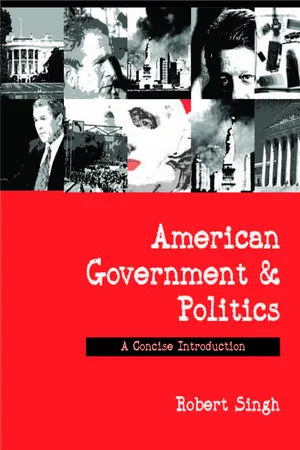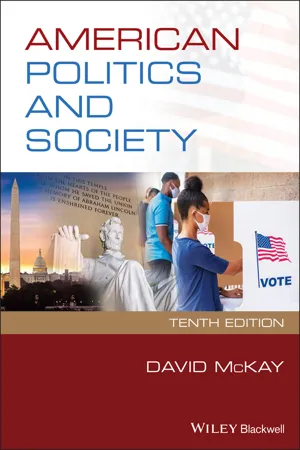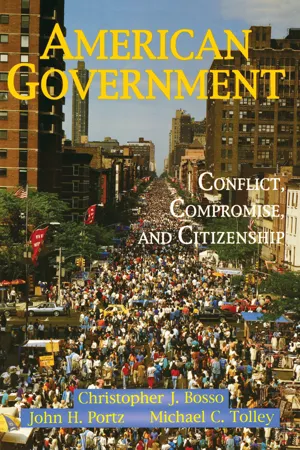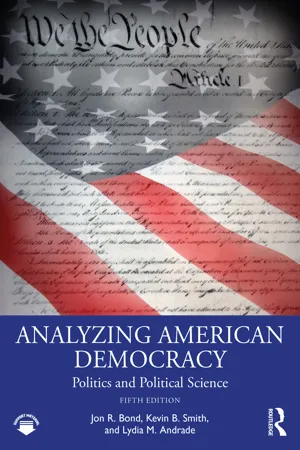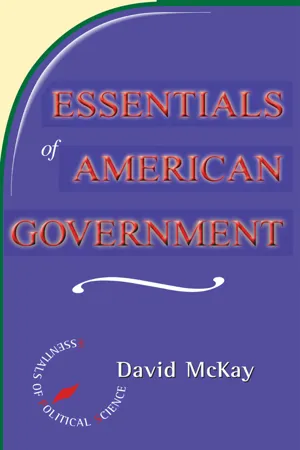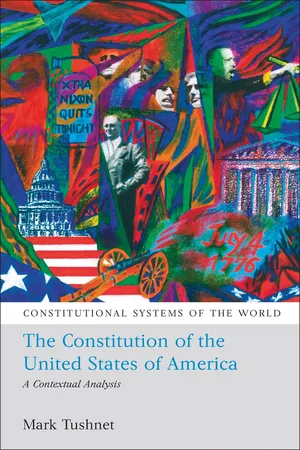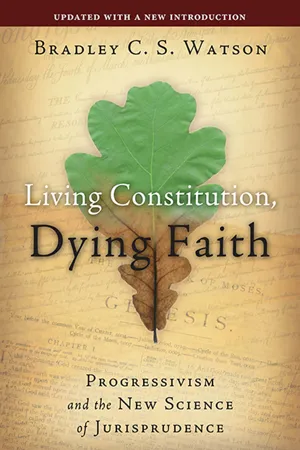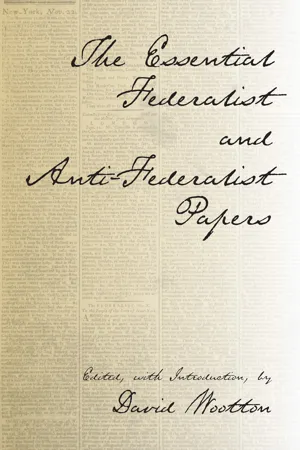History
American Constitution
The American Constitution is the supreme law of the United States, serving as the foundation for the country's government and legal system. It outlines the structure of the government, the rights of the people, and the division of powers between the federal and state governments. Ratified in 1788, it has since been amended 27 times to reflect the changing needs of the nation.
Written by Perlego with AI-assistance
Related key terms
10 Key excerpts on "American Constitution"
- eBook - ePub
American Government and Politics
A Concise Introduction
- Robert Singh(Author)
- 2002(Publication Date)
- SAGE Publications Ltd(Publisher)
2 The US Constitution We’ve got a fantastic Constitution. President George W. Bush, January 15, 2002Justice Thurgood Marshall, Bicentennial of the Constitution, 1987I do not believe that the meaning of the Constitution was forever ‘fixed’ at the Philadelphia Convention. Nor do I find the wisdom, foresight and sense of justice exhibited by the Framers particularly profound. To the contrary, the government they devised was defective from the start, requiring several amendments, a civil war and momentous social transformation to attain the system of constitutional government, and its respect for individual freedoms and human rights, we hold as fundamental today.- Origins: What did the Founding Fathers want to Achieve?
- Why has the Constitution endured so long and changed so little?
- Constitutional Amendment and Judicial Adaptation
- Interpreting the Constitution
- An Aid to Social Change or a Barrier?
- Conclusion
Chapter SummaryThe Constitution of the United States is the single most important feature of American government and – with the Declaration of Independence – the foundation of national unity. The Constitution’s significance to politics is immense. Its intimate connection with the republic’s founding means that American identity is inherently tied to the original document establishing a new and distinctive political settlement. Partly as a result, America’s pronounced political stability owes its greatest debt to the Constitution. Founded on a pervasive fear of majority tyranny, the Constitution sought to achieve a representative and republican system of government and an effective national government. But simultaneously, it also divided, limited and checked the power of government generally and the three branches of the federal government in particular. Akin to an elaborate game of ‘paper, rock, scissors’, any one branch can hamper the actions of another. Although the document has only been formally amended 27 times since 1787 – despite over 10,000 bills having been introduced in Congress to do so – the Constitution’s apparent changelessness masks its ‘unofficial’ adaptation by federal and state courts. Despite the many academic criticisms that have been made against it (not least its alleged inappropriateness for governing a twenty-first-century society), the Constitution remains revered by Americans. More than any other nation, political life is pervaded by the need for all branches of government, public officials and public policies to adhere to the federal Constitution’s provisions as supreme – the key guarantor of the rule of law and the preservation of political freedom, democracy and limited government. - eBook - ePub
- Michael Arnheim(Author)
- 2018(Publication Date)
- For Dummies(Publisher)
is a constitution? Okay, here goes. A constitution is a sort of super-law that regulates the way a country or state is run. How helpful is that as a definition? Not very? So let’s be more specific, and this time let’s focus specifically on the Constitution of the United States.The U.S. Constitution is the supreme law of the nation controlling the following main features (plus a few more):- The functions and powers of the different branches of the government: the President, the Congress, and the courts
- The way in which the President and the Congress are elected and how federal judges are appointed
- The way government officials — including the President and the judges — can be fired
- The relationship between the federal government and the states
- Your rights as a citizen or inhabitant of the United States
The word “constitution” can mean either the physical paper document or constitutional law as defined by the U.S. Supreme Court, which includes a number of features that don’t actually appear in the document, such as the rights to privacy, abortion, and gay marriage. These additional features are mainly a product of the so-called “living constitution” approach to the Constitution (as a document), which believes that the Constitution needs to be constantly reinterpreted to take account of changes in prevailing social, political, and moral values. On the other hand, strict constructionists, textualists, and originalists interpret the Constitution (as a document) sticking closely to the perceived original meaning of the words in question. I discuss the different approaches to constitutional interpretation in Chapter 3 .Knowing When and Why the Constitution Was Created
The Constitution emerged from a meeting called the Philadelphia Convention, which took place in 1787. (That meeting has since come to be known also as the Constitutional Convention. ) The Convention was held because the Articles of Confederation — the document that had been serving as the country’s first governing constitution — were considered to be weak and problematic (see Chapter 2 ). The stated goal of the Convention was to revise the Articles of Confederation, but the outcome was much more than a mere revision: It was a new form of government. See Figure 1-1 - eBook - ePub
- David McKay(Author)
- 2017(Publication Date)
- Wiley-Blackwell(Publisher)
Chapter 3 Constitutional GovernmentOutline
- Origins
- The American Constitution
- Biographies: Hamilton and Madison
- Ratification
- The Adaptive Constitution
- Assessing the Constitution
- Summary
- Questions for Discussion
- Glossary
- Notes
- Further Reading
The American Constitution is the most wonderful work ever struck off at a given time by the brain and purpose of man.– W. E. GLADSTONEGood government should be sufficiently neutral between the different interests and factions to control one part of the society from invading the rights of another, and at the same time sufficiently controlled itself, from setting up an interest adverse to that of the whole society.– JAMES MADISONAlmost all governments pay formal allegiance to a written or (more rarely) unwritten constitution, but in many countries constitutions represent only a limited constraint on the exercise of power. Even more rarely do constitutions survive political and social changes, invasions and wars. The American Constitution is unusual, both because it has remained almost unaltered since its ratification in 1789, and because it continues as a major source of authority in the political system. Indeed, even the most cursory examination of America’s basic political institutions – Congress, presidency, federalism, the electoral system – instantly shows the influence of the Constitution. To most foreign observers, the apparent resilience of the Constitution and constitutionalism is one of the most remarkable features of American politics, and one that requires some explanation. Among the most important questions raised by this phenomenon are: Why has the Constitution been amended so little through history? What real influence does it have today? In particular, by limiting the power of central government, has it helped to aggravate the tension between the public’s expectations of government and the ability of political institutions to satisfy those expectations? Before we tackle these questions it is necessary to approach the crucial issue of why the Constitution took the shape that it did. - eBook - ePub
- David McKay(Author)
- 2021(Publication Date)
- Wiley-Blackwell(Publisher)
CHAPTER 3 CONSTITUTIONAL GOVERNMENTOutline- Origins
- The American Constitution
- Biographies: Hamilton and Madison
- Ratification
- The Adaptive Constitution
- Controversy 3.1. How Democratic is the Constitution?
- Assessing the Constitution
- Summary
- Questions for Discussion
- Glossary
- Notes
- Further Reading
The American Constitution is the most wonderful work ever struck off at a given time by the brain and purpose of man.– W. E. GLADSTONEGood government should be sufficiently neutral between the different interests and factions to control one part of the society from invading the rights of another, and at the same time sufficiently controlled itself, from setting up an interest adverse to that of the whole society.– JAMES MADISONThe Electoral College severely distorts equal representation. Not only is it possible for a President to win the popular vote but not the election (which has occurred in four elections), but individual votes and their impact on the result vary a great deal state-to-state. For example, a vote in Wyoming is worth about four times as much as a vote from California– ROBERT DAHLAlmost all governments pay formal allegiance to a written or (more rarely) unwritten constitution, but in many countries constitutions represent only a limited constraint on the exercise of power. Even more rarely do constitutions survive political and social changes, invasions and wars. The American Constitution is unusual, both because it has remained almost unaltered since its ratification in 1789, and because it continues as a major source of authority in the political system. Indeed, even the most cursory examination of America’s basic political institutions – Congress, presidency, federalism, the electoral system – instantly shows the influence of the Constitution. To most foreign observers, the apparent resilience of the Constitution and constitutionalism is one of the most remarkable features of American politics, and one that requires some explanation. Among the most important questions raised by this phenomenon are: why has the Constitution been amended so little through history? Why are some features of the Constitution considered undemocratic? What real influence does it have today? In particular, by limiting the power of central government, has it helped to aggravate the tension between the public’s expectations of government and the ability of political institutions to satisfy those expectations? Before we tackle these questions it is necessary to approach the crucial issue of why the Constitution took the shape that it did. - eBook - ePub
American Government
Conflict, Compromise, And Citizenship
- Christopher J Bosso, John Portz, Michael Tolley(Authors)
- 2018(Publication Date)
- Routledge(Publisher)
Thus, to be an American is to be a part of a legal and political system defined by a document over 200 years old. No wonder scholars and citizens alike study the Constitution to figure out exactly what “the framers intended” in the same way that Jews consult the Torah, Christians the Bible, or Muslims the Koran. And, as befits its sacred stature, an original parchment copy of the Constitution is protected, alongside an original copy of the Declaration of Independence, behind thick glass and steel within the National Archives on Constitution Avenue in Washington, D.C.A POLITICAL DOCUMENTAmericans’ faith in their political system has been a source of tremendous social and political stability in an often unstable world. Without that faith, the system, and the nation, probably would not have survived very long.Yet reverence can be overdone. The Constitution is not religious dogma. It does not demand unquestioning faith. It is a political document, the plan for a political system. It is a framework of rules and procedures under which citizens and their elected representatives engage in conflict and, where possible, transform that conflict into some workable compromise. In this sense any constitution is best understood as a compact among citizens that both empowers government and limits what it can do. It also provides the means by which citizens can change rules that no longer work. Nor is any constitution meant to be unchanging or eternal: It too is meant to change when it no longer serves the needs of the people.The Constitution of the United States did not spring suddenly from the admittedly fertile minds of its drafters. Certainly it reflects the keen intellects of a uniquely gifted set of leaders—among them George Washington, James Madison, and Benjamin Franklin—but much of its direction and substance was the product of hard political experience, sharp economic and social conflicts, and pressing necessity. The Constitution’s underlying political ideals and its formal structure of government are deeply rooted in the history of a people. The document reflects deep-seated beliefs about the rights and responsibilities of virtuous citizens, as well as acute fears about the inherent dangers of government left unchecked. - eBook - ePub
Analyzing American Democracy
Politics and Political Science
- Jon R. Bond, Kevin B. Smith, Lydia Andrade(Authors)
- 2023(Publication Date)
- Routledge(Publisher)
None of this is to suggest that the Constitution is anything other than a brilliant piece of political engineering. It is. The point is that many of the ideas Americans hold about the Constitution are based more on feel-good mythology than any real understanding of what constitutes the historical and legal basis of the republic. In reality, the Constitution is less a sacred text and more of rulebook, a rulebook for the political system of the United States. If you do not understand the rulebook and how it came to be, the bottom line is that you cannot understand American government and politics. To ensure you have that understanding, this chapter examines what a constitution is, and provides a basic primer on the political history of the U.S. Constitution and the basic goals and purposes of democratic politics that it articulates.The Concept of a Constitution
A constitution is the basic framework of government that defines the nature and conduct of public authority.A constitution consists of three essential elements:- The functions of government: the powers and responsibilities that reside in the public rather than in the private sphere
- The structure of government: the institutions and mechanisms that constitute the framework of government
- The procedures of government: the manner in which government carries out the powers and responsibilities entrusted to it
constitutionA document or unwritten set of basic rules that provides the basic principles that determine the conduct of political affairs.Together, these elements provide the basic rules and guidelines for the exercise of political authority. Note that this is a definition of constitutions in general. The functions, structure, and procedures specified by a particular constitution determine whether the government is an autocracy, oligarchy, or democracy.Thus, a democratic constitution spells out how the core principles of democracy are to be upheld. Consider, for example, the powerful role of public officials and institutions in a representative democracy. They have the authority and power to make binding decisions regulating individual and group behavior. A constitution performs a similarly powerful role in relation to the public officials themselves; it determines what they can and cannot do and the nature of their relationship with other officeholders and the general populace. A state of mutual dependence and influence, therefore, characterizes a representative form of government. The people grant public officials the power to enact laws and decrees, but ordinary citizens ultimately control how that power is exercised. A democratic constitution spells out that popular sovereignty is the basis of political authority and constrains those who exercise that power from limiting the political freedom of others. - eBook - ePub
- David Mckay(Author)
- 2018(Publication Date)
- Routledge(Publisher)
3Constitutional GovernmentThe American Constitution is the most wonderful work ever struck off at a given time by the brain and purpose of man.—W. E. GladstoneGood government should be sufficiently neutral between the different interests and factions to control one part of the society from invading the rights of another, and at the same time sufficiently controlled itself, from setting up an interest adverse to that of the whole society.—James MadisonAlmost all governments pay formal allegiance to a written or (more rarely) unwritten constitution, but in few countries is the constitution a real and continuing constraint on the exercise of power. Even more rarely do constitutions survive political and social changes, invasions, and wars. The American Constitution is unusual, both because it has remained almost unaltered since its ratification in 1789, and because it continues as a major source of authority in the political system. Indeed, even the most cursory examination of America’s basic political institutions—Congress, the presidency, federalism, the electoral system—instantly shows the influence of the Constitution. To most observers, the apparent resilience of the Constitution and constitutionalism is one of the most remarkable features of American politics, and one that requires some explanation. Several important questions are raised by this phenomenon: Why has the Constitution been amended so little through history? What real influence does it have today? In particular, by limiting the power of central government, has it served to aggravate the tension between the public’s expectations of government and the ability of political institutions to satisfy those expectations? Prerequisite to answering these questions is the crucial issue of why the Constitution took the shape it did.Origins
Most dramatic regime changes following a revolution or war are quite easy to explain. France in 1789 was seething with discontent at a corrupt and insensitive monarchy. Russia in 1917 was long overdue for a revolution to sweep away an archaic, feudal order. And the numerous colonial wars of independence in the post-1945 period were predictable, given the rapid political and economic changes brought by World War II and its aftermath. - eBook - ePub
The Constitution of the United States of America
A Contextual Analysis
- Mark Tushnet(Author)
- 2008(Publication Date)
- Hart Publishing(Publisher)
1
An Overview of the History of the US Constitution
When in the late nineteenth century scholars began to write constitutional histories of the United States, they went back to the forest of Germany and Magna Carta to identify the origins of US constitutionalism. For our purposes a more compressed time frame is appropriate. This Chapter surveys constitutional developments from the Revolutionary era through the early twenty-first century, to provide some orientation to the analytical account of US constitutional development that will occupy the remainder of the book. A single short chapter is obviously inadequate to provide more than the barest sense of the course of constitutional development; we will return to some of the episodes noted here in later chapters, which will also provide additional examples that retrospectively fill in some details omitted here.FROM THE REVOLUTION TO THE BILL OF RIGHTS
The British colonies on the North American continent began to push for independence in the aftermath of the French and Indian Wars of the mid-eighteenth century. By the early 1770s a group of politically active colonists had become increasingly dissatisfied with the imposition on them of regulations adopted by the remote British Parliament in which they had no direct representation. They organized ‘committees of correspondence’ which began as local groups of independence-minded colonists who coordinated their efforts across colonies but which eventually became quasi-governments parallel to the colonial legislatures under British control.1Meeting in Philadelphia, the colonists declared independence in 1776. Organized as a ‘Continental Congress’ with representatives from each of the colonies, the rebels began to create something resembling a government for what they hoped would become a new and independent nation. That government was a loose confederation of the former colonies, now denominated ‘states’. Near the end of the decade the states decided to regularize their government by entering into a formal confederation. The Articles of Confederation were drafted in 1777 and became effective in 1781, during the Revolutionary War. - eBook - ePub
Living Constitution, Dying Faith
Progressivism and the New Science of Jurisprudence
- Bradley C. S. Watson(Author)
- 2020(Publication Date)
- Intercollegiate Studies Institute(Publisher)
Cultural traditions often cut against the acknowledgment of natural rights. Even in the United States, one can say that constitutional democracy was by no means inevitable. The American Founders thought and acted with great originality and boldness and had broad sympathy for the nascent principles of liberty. But had America not been settled largely by Englishmen, or at least those familiar with the English conception of liberty, it would, without question, have been a very different country. American understandings and institutions simply would not have taken the shape they did, had not the Founders been profoundly influenced by the constitutional history, political philosophy, and common-law doctrines originating in England. For many of the Founders, the constitutional history of England was the story of the gradual limitation of royal power, from Magna Carta (1215), to the Petition of Right (1628), to the development of the common-law and independent courts, to the “Glorious Revolution” of 1688–89. Of this latter event, Locke’s Second Treatise gave a theoretical account, arguing that legitimate sovereign power comes only from a compact among the people, acting through parliament, and limiting the prerogatives of the king. 7 By the mid-1760s, this social-compact theory was explicitly influencing many members of the founding generation and was being voiced in the pulpits and in pamphlets. As Henry Steele Commager has argued, what united the Founders—even Jefferson and Hamilton—far outweighed what divided them. 8 Beyond English constitutional history, they were steeped in a uniquely American Enlightenment, which drew on a great wellspring of common ideas and historical events, from classical to modern times. This background was the soil in which a vigorous Whig history took root. In expounding and institutionalizing certain philosophic principles, the Founders relied on a historically situated narrative, that led to their—the American—creed - Alexander Hamilton, James Madison, John Jay, David Wootton(Authors)
- 2003(Publication Date)
- Hackett Publishing Company, Inc.(Publisher)
There necessarily exists in every government a power from which there is no appeal; and which, for that reason, may be termed supreme, absolute, and uncontrollable. Where does this power reside? To this question, writers on different governments will give different answers. Sir William Blackstone will tell you, that in Britain the power is lodged in the British Parliament, that the Parliament may alter the form of the government; and that its power is absolute without control. The idea of a constitution, limiting and superintending the operations of legislative authority, seems not to have been accurately understood in Britain. There are, at least, no traces of practice conformable to such a principle. The British constitution is just what the British Parliament pleases. When the Parliament transferred legislative authority to Henry VIII, the act transferring could not in the strict acceptation of the term be called unconstitutional.To control the power and conduct of the legislature by an overruling constitution was an improvement in the science and practice of government reserved to the American states.Perhaps some politician, who has not considered, with sufficient accuracy, our political systems, would answer, that in our governments, the supreme power was vested in the constitutions. This opinion approaches a step nearer to the truth; but does not reach it. The truth is, that, in our governments, the supreme, absolute, and uncontrollable power remains in the people. As our constitutions are superior to our legislatures; so the people are superior to our constitutions. Indeed the superiority, in this last instance, is much greater; for the people possess, over our constitutions, control in act, as well as in right.The consequence is, that the people may change the constitutions whenever and however they please. This is a right, of which no positive institution can ever deprive them.These important truths, sir, are far from being merely speculative. We, at this moment, speak and deliberate under their immediate and benign influence. To the operation of these truths, we are to ascribe the scene, hitherto unparalleled, which America now exhibits to the world—a gentle, a peaceful, a voluntary, and a deliberate transition from one constitution of government to another. In other parts of the world, the idea of revolutions in government is, by a mournful and an indissoluble association, connected with the idea of wars and all the calamities attendant on wars. But happy experience teaches us to view such revolutions in a very different light—to consider them only as progressive steps in improving the knowledge of government, and increasing the happiness of society and mankind.
Index pages curate the most relevant extracts from our library of academic textbooks. They’ve been created using an in-house natural language model (NLM), each adding context and meaning to key research topics.
